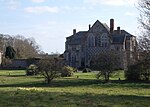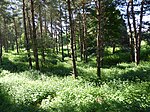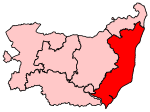Chillesford Church Pit
Geological Conservation Review sitesSites of Special Scientific Interest in Suffolk

Chillesford Church Pit is a 1.1-hectare (2.7-acre) geological Site of Special Scientific Interest in Chillesford, south of Saxmundham in Suffolk. It is a Geological Conservation Review site, and it is in the Suffolk Coast and Heaths Area of Outstanding Natural Beauty.This site has deposits dating to the Early Pleistocene Bramertonian Stage, around 2.4 to 1.8 million years ago. Fossils of molluscs and pollen indicate a temperate climate dating to the Chillesford Crag formation. The Chillesford Clay and Chillesford Crag are parts for the Norwich Crag Formation.The site is private land with no public access.
Excerpt from the Wikipedia article Chillesford Church Pit (License: CC BY-SA 3.0, Authors, Images).Chillesford Church Pit
Orford Road, East Suffolk
Geographical coordinates (GPS) Address Nearby Places Show on map
Geographical coordinates (GPS)
| Latitude | Longitude |
|---|---|
| N 52.117 ° | E 1.478 ° |
Address
Orford Road
IP12 3PR East Suffolk
England, United Kingdom
Open on Google Maps











